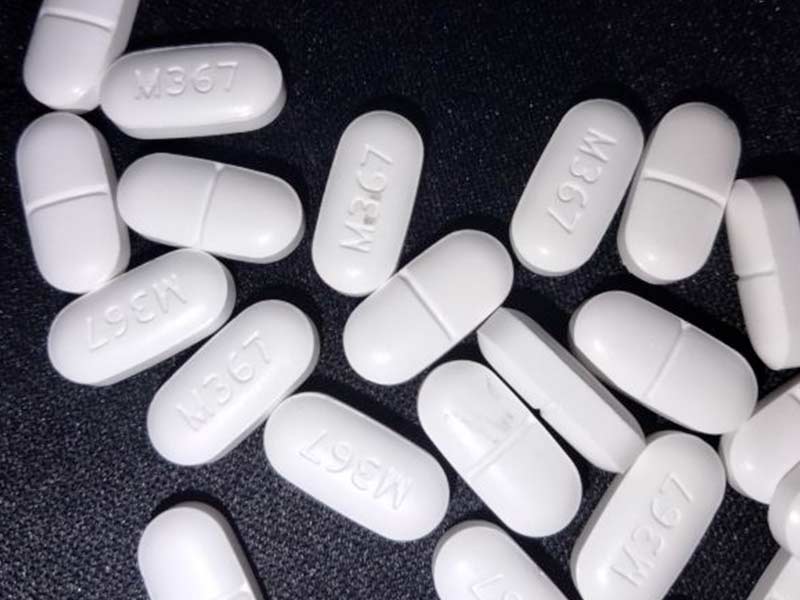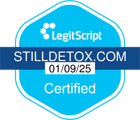What is M367 White Oblong Pill?
Pill with imprint M367 is white, oblong, capsule-shaped and has been identified as a combination medication containing 10 mg of hydrocodone bitartrate (a narcotic opioid) and 325 mg of acetaminophen (commonly known as Tylenol). It is supplied by Mallinckrodt Pharmaceuticals and is commonly prescribed for moderate to severe pain relief.
Acetaminophen/hydrocodone 325 mg/10 mg is classified as a Schedule II controlled substance under the Controlled Substances Act (CSA) due to its high potential for abuse and addiction.
Key Points
- M367 pills (hydrocodone/acetaminophen) are strong opioid painkillers highly prone to misuse and addiction. They are prescribed for pain but easily lead to dependence due to their euphoric and relaxing effects.
- Counterfeit M367 pills are widespread and incredibly dangerous. They often contain fentanyl and are almost impossible to distinguish from real pills by sight, posing a severe overdose risk.
- M367 pills, especially with long-term use, cause serious health problems: heart issues, digestive problems, and mental health decline, and tolerance. Abuse escalates these risks significantly.
- Quitting M367 suddenly is dangerous due to severe withdrawal. Medically supervised detox is essential for safe withdrawal and recovery. Help is available for those struggling with addiction.
- Norco 10/325
- Vicodin
- Lortab
- Hycet
- Norcos
- Hydro 10 mg
- Tabs
- Vikes
What Is the M367 White Oblong Pill Used For?
Doctors prescribe M367 white long pills for moderate to severe pain, especially for conditions where non-opioid pain relievers are not effective. It is commonly used for:
- Post-surgical pain relief
- Chronic pain (e.g., arthritis, lower back pain)
- Injury-related pain
- Cancer pain management
The hydrocodone in M367 white oval pills binds to opioid receptors in the brain and spinal cord, blocking pain signals while inducing relaxation and euphoria. The acetaminophen component is included to enhance pain relief, but it also presents a serious risk of liver damage when taken in excessive doses.
Acetaminophen is considered safe in controlled amounts, but the maximum recommended daily dose is 4,000 mg. Since each M367 white oblong pill contains 325 mg of acetaminophen, consuming more than 12 pills in a single day can result in acute liver failure (Mayo Clinic).
How M367 Pill Makes You Feel
When taken as prescribed, M367 pills make you feel:
- Pain relief (you stop noticing discomfort as much)
- A sense of relaxation and calmness
- Mild euphoria
- Drowsiness and sedation
But when taken in higher doses or misused, the effects become more intense. Some describe it as a floating sensation, a warm wave of relaxation, or feeling detached from stress and reality. Others say it’s like a weight lifting off their chest—a break from physical and emotional pain.
Misuse often happens in different ways:
- Taking extra pills when the effects wear off too soon
- Crushing and snorting M367 white pills to feel the high faster
- Mixing with alcohol or benzodiazepines to enhance sedation
This is where dependence begins—not necessarily because someone wants to get high, but because they start relying on M367 just to feel okay.
How Long Does M367 Take to Kick In and Wear Off?
The M367 white oval pill typically starts working within 30 to 60 minutes, with peak effects occurring around 1 to 2 hours after ingestion. The effects usually last between 4 to 6 hours.
For those who snort or inject the drug, the onset is almost immediate, but the high is shorter-lived, leading to more frequent use and a higher risk of overdose.
How Quickly Can You Get Addicted to M367?
According to the CDC, taking opioids for as little as 5 to 7 days can cause physical dependence, and cravings can start within two weeks (CDC Drug Overdose Rates).
The process is gradual:
- You start taking M367 as prescribed—relief is good.
- Your body adjusts—the same dose doesn’t work as well.
- You take a little extra—to get the same effect.
- You begin to need it—not just for pain, but to feel normal.
Many believe opioid addiction only happens to those who misuse drugs, but research shows even short-term use can lead to dependence. Once this happens, stopping M367 pills suddenly can cause intense withdrawal symptoms, making it harder to quit.
How to Get Off M367 Without Painful Withdrawal
Quitting M367 white pills cold turkey can cause severe withdrawal symptoms, including:
- Bone-crushing body aches
- Uncontrollable sweating
- Vomiting, diarrhea, and shaking
- Severe anxiety and depression
If you or someone you love is struggling, don’t wait until it’s too late. Call Still Detox in Boca Raton, Florida at 561-556-2677 to safely detox under medical supervision.
Counterfeit M367 Pills
If you’re searching for M367 white oval pill identification, be cautious—fake versions are everywhere.
In 2016, the California Poison Control Center found counterfeit M367 pills laced with fentanyl, promethazine, and cocaine (CDC, 2016).
Signs that an M367 white oblong pill is fake:
- It crumbles easily or looks powdery
- The imprint is faded or inconsistent
- It came from an unknown source (not a pharmacy)
If you suspect a pill is fake, DO NOT take it—it could be deadly within minutes.
How M367 White Oblong Pills Affect Your Body
Long-term use of M367 white oblong pills can lead to serious cardiovascular, digestive, and mental health complications. Chronic heart irregularities, digestive issues, or mood changes while taking M367 should not be ignored. Many individuals increase their dosage over time just to feel normal, which raises the risk of long-term damage, dependence, and severe health consequences.
How M367 Pills Affect the Heart
Irregular Heartbeats (Arrhythmias)
Hydrocodone, the opioid in M367 white pills, slows down the nervous system, which can interfere with the heart’s normal rhythm. Some users report feeling their heart skip beats or suddenly speed up, which increases the risk of developing dangerous arrhythmias (American Heart Association, 2023).
QT Prolongation and Fatal Heart Rhythms
A lesser-known but severe risk of M367 white oblong pills is QT interval prolongation. This condition disrupts the heart’s electrical signals and significantly increases the risk of Torsades de Pointes, a dangerous arrhythmia that can cause sudden cardiac arrest (Journal of the American College of Cardiology, 2023).
How M367 Pills Affect Mental Health
M367 white oblong pills increase dopamine levels, creating a sense of pleasure and relief. Over time, the brain produces less dopamine naturally (National Institute on Drug Abuse, 2023) leading to:
- Emotional detachment or lack of motivation
- Severe mood swings and irritability
- Increased anxiety or panic attacks
How M367 Pills Affect the Digestive System
Opioids like M367 white oval pills slow down movement in the digestive tract, leading to chronic constipation and bloating. Some users find themselves unable to pass stool for days or even weeks, which can turn into a life-threatening bowel obstruction [NIDA].
What Happens If You Stop M367 Pills Suddenly?
Stopping M367 white oval pills suddenly can trigger severe emotional crashes. Many people experience severe mood swings, irritability, and suicidal thoughts when quitting opioids too quickly. This is because the brain needs time to start producing dopamine again.











